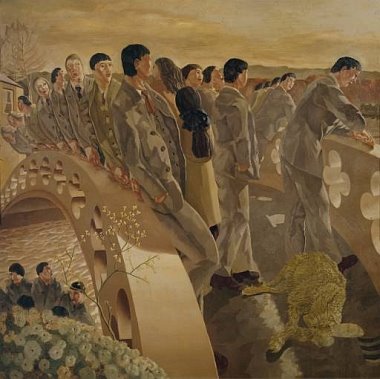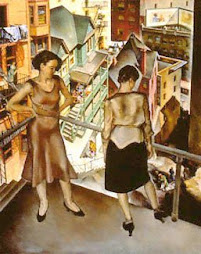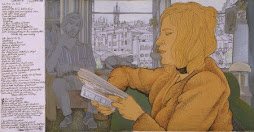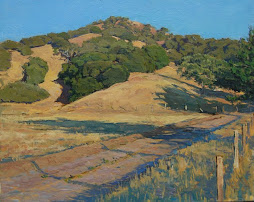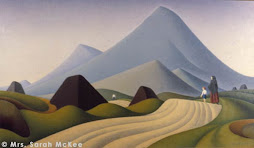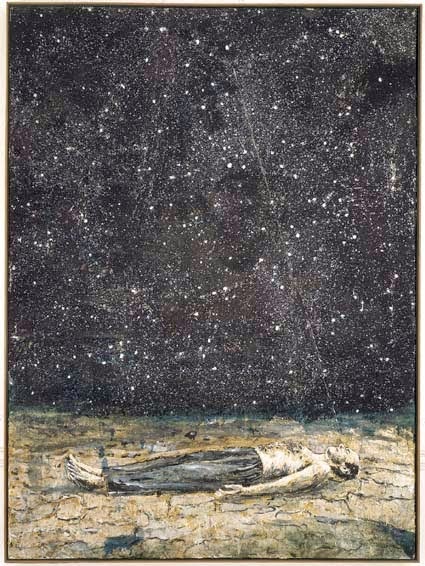

A critic strives to reconnnect ordinary readers with a book meant for, and about, the rest of us. His colleagues strangle
Ulysses in theoretical nets; average folks often fear, mock or abandon it. Unfairly, Kiberd insists; Joyce teaches us how to understand his narrative.
Kiberd rues: "A book which set out to celebrate the common man and woman endured the sad fate of never being read by most of them. Was this a case of bad faith or bohemian hypocrisy in a work which idealised just the sort of simple souls who could never hope to read it?" (7) This guide and commentary-- unlike his own handy Penguin 1992
Annotated Student's Edition (never available in the US and enmeshed in the copyright battles over the Joyce estate abroad; based on the Bodley Head 1960 printing)-- does not seek a line-by-line commentary. However, it'd be a welcome primer. As with David Pierce's similarly themed, recent
Reading Joyce (my
Epona joint review of Pierce & Kiberd's in press), Kiberd blows away dust. Neither book might be the very first to consult when taking up this novel, but they'd come early on in one's supplemental instruction. Both scholars show us how a century ago readers came to face this work, and how, after nearly another century, aided by scholarship, we can restore the wonder of this dazzling narrative.
Bohemia may have inspired early Joyce, but
Ulysses determines to be less Stephen Dedalus and more Leopold & Molly Bloom: it's a bourgeois setting. It celebrates the mundane and tells how to recapture the awe in the everyday moment "In that context,
Ulysses exists like a blasted road sign in a war zone, pointing at a future that is exhilarating to precisely the extent that it is uncertain and open." (21)
This work promotes an engaged Everyman, but the failure of the 20th century it heralded shows that its "world so lost turns out to have been far better than that which replaced it." We lack middle-class culture that modernism, social democracy, and the text sought to place within our grasp. Instead, "mass entertainment" reduces "all the oppositional forces of modernism" to supplant them with "only the identikit shopping mall, the ubiquitous security camera and the celebrity biography." Our train conductor will not regale us with a quote from Shakespeare as we alight in Limerick; "overpaid experts and underpaid service providers" replaced the sidewalk flaneur and public character on the street with us, scurrying towards our locked cars "from one private moment to another." (24)
The next chapter on the novel's ties back to the Irish past and its revival promises an emphasis, for once, on Irish-language predecessors. This subject could display Kiberd's bilingual expertise. Yet, beyond typically provocative asides such as how the novel might be reconfigured as "a central text of the Gaelic revival," this theme languishes in far too brief a section. (36)
Eighteen chapters follow. It would have helped to have a preface to this book explaining Kiberd's overall aims. Kiberd gives over the bulk of his necessarily brisk explication; by titling each of his chapter commentaries on "Ulysses" with a verb he neatly remind us of its predominant action: "Waking; Learning; Thinking; Walking; Praying; Dying; Reporting; Eating; Reading; Wandering; Singing; Drinking; Ogling; Birthing; Dreaming; Parenting; Teaching; Loving."
Stephen keeps the British confused; his rebellion's neither as lackey nor terrorist. "He refuses to be easily decoded. So in truth does Joyce's book." (49) The novel rescues one day from dullness. On 16 July 1904 when not much happened historically, a lot gets recorded imaginatively. This frees its Irish characters.
Shifting from Stephen with Deasy's conversation, via Sandymount strand, then to Bloom's monologue, Kiberd links them with an easily overlooked motif. His observant eye assists experienced readers to recall images and associations rewarding repeated visits to the text. While "Deasy valued shells" for what they were as objects, "and not for the life which they contained," young Dedalus "seeks their inner meaning, the soul which animates their exterior form." (64) Bloom will soon praise the first man bold enough to eat an oyster; later Kiberd muses about Bloom's attraction for Molly as "Sirens" ends: "The rhythm of sex, like the rise and fall of the sea-tides, produces desire and then forgiveness, a sound to be heard in the seashell thrown up on the beach (though what is heard is really the pulsing of the listener's own blood)." (177-78)
Like
Ulysses, Kiberd's focus rapidly may alter. The chapters move quickly as their source-text does. The pace of both author and critic demands attention to details. A Latin Quarter hat, Plumtree's Potted Meat, the "U.P." postcard message, Bloom's defecation all earn scrutiny. The first three episodes present "a version of the problem to which Bloom might be the answer." (80-81) Styles alter every chapter, Kiberd suggests, to further the reader's education as much as Stephen's, as the bohemian pose of the student with the hat weakens under the force of the bourgeois life examined scrupulously-- by a newspaper ad, a rumor, the body's demands-- so as to release wonder from daily routine.
A critic may, after immersion, adapt the text so long cited into his or her own prose. Kiberd begins "Dying": "At funerals people formally mourn the dead person, while privately experiencing an even deeper sadness for those who remain in the world." (100) The chapter on another theme starts: "Reading was often the last thing on Joyce's mind when he visited the National Library. Like many Dublin libraries, it was used more for talk than study." (157) Kiberd remarks about the city he shares with Joyce: "In Dublin there are only two kinds of joke-- those that were once funny, and those that were never funny." (104) The avuncularity of these comments shadows their sharpness, in true civic register.
The difficulty of keeping a tone, for author, emerges for this critic early on in the interior monologues. Even by the newspaper visit, the insertion of headlines shows the dangers of misleading a reader, as a sub-editor often has not studied the articles themselves under pressure of deadlines. Kiberd uses this example to illustrate Joyce's risk-taking. Unsure of his own tonal perfection, Joyce warns of language churned out mechanically, formulaically "Joycean." So, the author as a clever modernist keeps updating his art, with no version staying "final" or "official." Similarly, as this editor knows, he and his colleagues add to the textual indeterminacy of never one "authorized" text of "Ulysses."
Instability in "Cyclops" widens the gaps as the narrative continues. Bloom's monologue goes missing. Interior richness fades at Barney Kiernan's. The Gaelic literary tradition's oral culture's "shreds and radiant fragments" break the chapter's juxtapositions into banal barstool dialogue. Not even Joyce, Kiberd holds, could sustain the "density" of earlier chapters, and gaps open up to allow other voices to enter the novel.
Similarly, as Bloom's watch stops at the time of the assignation of Blazes Boylan with Molly at 4 p.m., so the narrative skips and hastens. What in "Nausikaa" alternated between Bloom and Gerty and then merged briefly increases in "Oxen of the Sun" as Joyce takes on all of English literature (with as Kiberd notes the exceptions of Chaucer and Shakespeare) as the author determines to escape any system able to hold him down. Kiberd emphasizes the novelty of
Ulysses: "its strategies changed as it was written, by way of the writer's reaction to the reception of earlier episodes, and with no clear sense of the total conception until the final phase was written." (225) The pace quickens and the prose often thickens, until, in Nighttown, it leaves chronology behind for "the timeless zones of the unconscious."
We learn in "Ithaca" much about Stephen and Bloom that monologues could not tell us. Their conversations in "Eumaeus" remained wayward, warm if tentative. These sections, often discouraging readers, regain their worth in Kiberd's interpretation. A combination of the parental role of Bloom in the former and the catechetical mode of the latter chapter shows how the intellectual may reclaim the ordinary. After Stephen leaves, thoughts of a psalm of liberation accompany him. Left behind, Bloom goes to bed. There the novel was supposed to have ended.
Yet, "as Molly counter-signed her husband's passport to eternity," surprises await. (259) Masturbation, uniting solitary spouses that day, found both Blooms soon thinking of each other. This subversive action, Kiberd holds, represents a satisfaction that neither the glimpse of Gerty or the embrace of Blazes could. As for the often contradictory sections of Molly's revelations, Kiberd proposes that she be treated not "as a definite person," but "'the voice of the book,' a voice that breaks out of gender confines and individual identity." (272) As for her husband, so for Molly; they can be seen "moving out of time and into the infinite."
Five chapters of this study close with literary antecedents. The influence of the "Odyssey" moves Kiberd to regard Homer's epic as anticipating "many features of the lives of the civic bourgeoisie," while Joyce's response laments "bourgeois virtues that were fast disappearing." (282) Prophetic modes in the Old Testament fulfilled in the New play off of latent powers unleashed in
Ulysses. Lacking any quotation marks within, this novel encompasses all voices that predicted it.
Dante and
Hamlet offer two examples of how masters may guide followers through danger, on pilgrimage and in coming-of-age. These essays recall Erich Auerbach's comparative perspectives, and roam as widely. Throughout, Kiberd grounds most of
Ulysses in its quotidian, even modest, assertions of the mundane as magical. The interpreter of the past strives to recover a fidelity that the present can never match. Yet, in this dismantling of the original, a new text responds and renews it.
Response and renewal, by ingesting earlier texts and cannibalizing his own, characterize Joyce's process to resist incorporation and parody by his literary heirs. Kiberd reiterates the contents of
Ulysses that emerge once its scaffolding falls away, its veils drop. As wisdom literature no less than the Torah: "Everything was in the holy book, including all that had been known to predecessors." (301) The Irish epic binds the sacred to the mundane. Bloom's humility corrects Stephen's aestheticism. The body, as both Blooms show, can soothe the overexcited mind. Intellect need not be divorced from experience, as the sacramental transformation in
Ulysses emerges by "an almost tantric sense of delayed gratification." (353) In a world far busier than Joyce's, Kiberd urges readers-- in this helpful guide by another textual master-- to reclaim the magic within not only this great story's telling, but in our own relationships, objects, thoughts, and words.
P.S. I caught three minor slips in this work that relies on a wealth of knowledge as vast as its inspiration. "If you meet the Buddha on the road, kill the Buddha" Kiberd attributes on pg. 191 to the Buddha, but this koan conventionally has been credited to the founder of the Zen Rinzai sect, Linji. "St. Theresa" should be Teresa, as "of Avila"-- not Therese of Lisieux-- part of one of "saintly couples" on pg. 275, here aligned with St. John of the Cross. The "famous NASA photograph of the earth" was not "taken from the moon in 1969." (327) It was sent as "Earthrise" from the lunar orbiter Apollo 8, Christmas Eve 1968.
(P.P.S. Again in the transatlantic publishing battle, those Brits beat us Yanks. So, is copyright [as with so much in the Joyce industry] to blame? Why Eve Arnold's ca. 1952 snap of Marilyn Monroe graces the Faber cover while we're peddled Norton's duller shot of the early edition of this big fat tome by duller comparison beats me.) (A somewhat briefer review appeared on Amazon US 12-15-09, cross-posted to my blog for longer reviews "Not the L.A. Times Book Review.")
 Cleachtaim, ag síul a dhéanamh go rialta. Bím ag dul leis an muileann coise. Mar sin féin, bhí mé dúil an lá eile ag imeacht faoin tuatha ann.
Cleachtaim, ag síul a dhéanamh go rialta. Bím ag dul leis an muileann coise. Mar sin féin, bhí mé dúil an lá eile ag imeacht faoin tuatha ann.

















